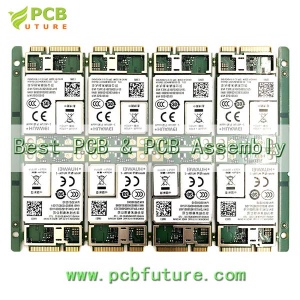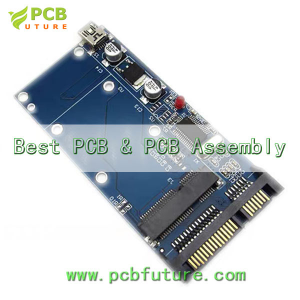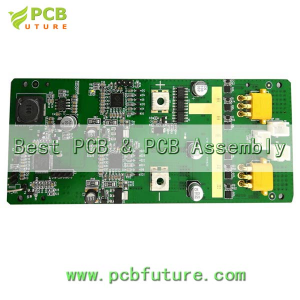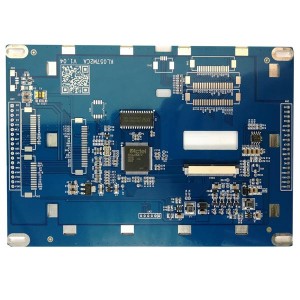5 important PCB panelization design tips for PCB Assembly
In the process of PCB assembly, we will need the SMT machines to paste the components on the PCB. But since every PCB’s size, shape or components are different, in order to better adapt to SMT assembling process, improve efficiency and reduce the assembly cost. That’s why PCB assembly manufacturer need to standardize the panelization of PCB. PCBFuture provide you 5 guildlines for your PCB panelization for better PCB assembly.
Tips 1: The size of PCB
Description: The size of the PCB is limited by the capabilities of the electronic processing production line equipment. Therefore, the size of PCB should be considered when we are designing the product solutions.
(1) The maximum PCB size that can be mounted on SMT PCB assembly equipment depends on the standard size of the PCB, most of the size is 20″×24″, that is rail width is 508mm×610mm.
(2) The size we recommend is that matches the equipment of the SMT PCB board line. It is beneficial to the production efficiency of each equipments and eliminates the bottleneck of the equipment.
(3) For small-size PCBs, we should be designed as splicing board to improve the production efficiency of the entire production line.
Design requirements:
(1) Generally, the maximum size of the PCB should be limited to the range of 460mm×610mm.
(2) The recommended size range is (200~250) × (250~350) mm, and the aspect ratio should be less than 2.
(3) For PCBs with a size less than 125mm×125mm, the PCB should be spliced to a suitable size.
Tips 2: The shape of the PCB
Description: SMT assembling equipment uses guide rails to transfer PCBs, and cannot transfer irregular-shaped PCBs, especially PCBs with gaps in the corners.
Design requirements:
(1) The shape of the PCB should be a regular square with rounded corners.
(2) In order to ensure the stability of the transmission process, the irregularly shaped PCB should be considered to be converted into a standardized square by splicing, especially the corner gaps should be filled in order to avoid the wave soldering being clamp by the jaws and then causing the board to be jammed during the transfer.
(3) The pure SMT board is allowed to have gaps, but the gap size should be less than one-third of the length of the side where it is located. For those that don’t meet this requirement, we should make up the length of the design process.
(4) In addition to the chamfering design of the golden finger, the edges on both sides of the insert should also be chamfered (1~1.5) × 45° to facilitate insertion.
Tips 3: The PCB tooling stips (PCB borders)
Description: The size of the PCB boarders on the requirements of the conveying rail of the equipment. Such as: printing presses, placement machines and reflow soldering furnaces. They are usually required to convey the edge (Border) above 3.5mm.
Design requirements:
(1) In order to reduce the deformation of the PCB during soldering, the long side direction of the non-imposed PCB is generally used as the transmission direction. And the splice PCB, the long side direction should also be used as the transmission direction.
(2) Generally, the two sides of the PCB or splice PCB transmission direction are used as the transmission side (PCB borders). The minimum width of the PCB borders is 5.0mm. There should be no components or solder joints on the front and back of the transmission side.
(3) For the non-transmission side, there is no restriction in the SMT PCB assembly equipment, but it is better to reserve a 2.5mm component forbidden area.
Tips 4: Positioning hole
Description: Many processes such as PCB manufacturing, PCB assembly, and testing require accurate positioning of the PCB. Therefore, it is generally required to design positioning holes.
Design requirements:
(1)For each PCB, at least two positioning holes should be designed, one is circular and the other is long groove shape, the former is used for positioning and the latter is used for guiding.
There is no special requirement for the positioning aperture, it can be designed according to the specifications of your own factory. The recommended diameter is 2.4mm and 3.0mm.
Locating holes shall be non metallized. If the PCB is a blanking PCB, the hole plate should be designed for positioning hole to enhance rigidity.
The length of the guide hole is usually 2 times of the diameter.
The center of the positioning hole should be more than 5.0 mm away from the transmission side, and the two positioning holes should be as far away as possible. It is recommended to lay them at the diagonal of the PCB.
(2)For mixed PCB (PCBA with plug-ins installed), the location of positioning holes should be consistent. In this way, the design of tooling can achieve the common use of both sides. For example, the screw bottom bracket can also be used for plug-in tray.
Tips 5: Positioning fiducial
Description: The modern mounter, printer, AOI and SPI all adopt optical positioning system. Therefore, optical positioning fiducial must be designed on PCB board.
Design requirements:
Positioning fiducial are divided into global fiducial and local fiducial. The former is used for the whole board positioning, and the latter is used for the positioning of patchwork daughter board or fine spacing components.
(2)The optical positioning fiducial can be designed as square, diamond circle, cross and well with a height of 2.0 mm. Generally, it is recommended to design a 1.0m round copper definition figure. It is consider the contrast between the material color and the environment, a non resistance welding area 1 mm larger than the optical positioning fiducial should be reserved. It is no characters are allowed in the area. Whether there is copper foil in the inner layer under three symbols on the same board surface should be consistent.
(3) On the PCB surface with SMD components, it is suggested to lay three optical positioning fiducial on the corner of the board, so as to position the PCB stereoscopically (three points determine a plane, which can detect the thickness of solder paste).
(4) In addition to three optical positioning fiducial for the whole plate, it is better to design two or three optical positioning fiducial at the corners of each unit plate.
(5) For QFP with lead center distance less than or equal to 0.5 mm and BGA with lead center distance less than or equal to 0.8 mm, local optical positioning fiducial should be set at the opposite corners to accurate positioning.
(6) If there are mounting components on both sides, there should be optical positioning fiducial on each side.
(7) If there is no positioning hole on the PCB, the center of the optical positioning fiducial should be more than 6.5mm away from the transmission edge of the circuit board. If there is a positioning hole on the PCB, the center of the optical positioning fiducial should be designed on the side of the positioning hole near the center of the PCB board.
PCBFuture can provide with Turnkey PCB assembly service which including PCB Fabrication, PCB population, Components sourcing and testing. Our engineers will help our customer to panelize the boards before PCB production, and then after finishing test, we will help to break into each piece and ship to our customers. If you have any questions about PCB design, feel free to contact to us. We can provide you with free technical supports.
For more questions, please send email to service@pcbfuture.com .
Post time: Mar-20-2021








